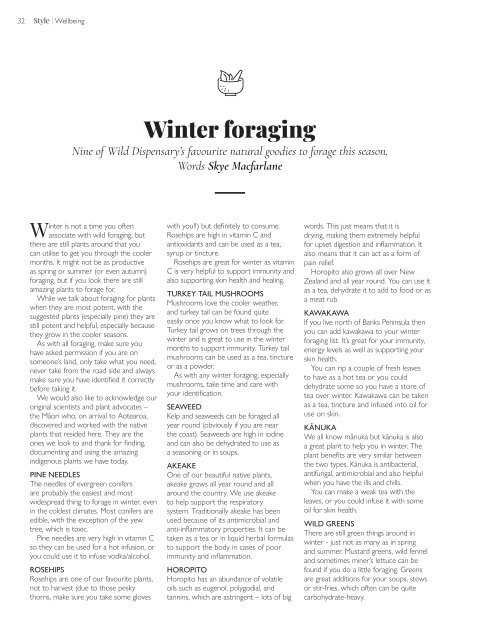Create successful ePaper yourself
Turn your PDF publications into a flip-book with our unique Google optimized e-Paper software.
32 <strong>Style</strong> | Wellbeing<br />
Winter foraging<br />
Nine of Wild Dispensary’s favourite natural goodies to forage this season.<br />
Words Skye Macfarlane<br />
Winter is not a time you often<br />
associate with wild foraging, but<br />
there are still plants around that you<br />
can utilise to get you through the cooler<br />
months. It might not be as productive<br />
as spring or summer (or even autumn)<br />
foraging, but if you look there are still<br />
amazing plants to forage for.<br />
While we talk about foraging for plants<br />
when they are most potent, with the<br />
suggested plants (especially pine) they are<br />
still potent and helpful, especially because<br />
they grow in the cooler seasons.<br />
As with all foraging, make sure you<br />
have asked permission if you are on<br />
someone’s land, only take what you need,<br />
never take from the road side and always<br />
make sure you have identified it correctly<br />
before taking it.<br />
We would also like to acknowledge our<br />
original scientists and plant advocates –<br />
the Māori who, on arrival to Aotearoa,<br />
discovered and worked with the native<br />
plants that resided here. They are the<br />
ones we look to and thank for finding,<br />
documenting and using the amazing<br />
indigenous plants we have today.<br />
PINE NEEDLES<br />
The needles of evergreen conifers<br />
are probably the easiest and most<br />
widespread thing to forage in winter, even<br />
in the coldest climates. Most conifers are<br />
edible, with the exception of the yew<br />
tree, which is toxic.<br />
Pine needles are very high in vitamin C<br />
so they can be used for a hot infusion, or<br />
you could use it to infuse vodka/alcohol.<br />
ROSEHIPS<br />
Rosehips are one of our favourite plants,<br />
not to harvest (due to those pesky<br />
thorns, make sure you take some gloves<br />
with you!!) but definitely to consume.<br />
Rosehips are high in vitamin C and<br />
antioxidants and can be used as a tea,<br />
syrup or tincture.<br />
Rosehips are great for winter as vitamin<br />
C is very helpful to support immunity and<br />
also supporting skin health and healing.<br />
TURKEY TAIL MUSHROOMS<br />
Mushrooms love the cooler weather,<br />
and turkey tail can be found quite<br />
easily once you know what to look for.<br />
Turkey tail grows on trees through the<br />
winter and is great to use in the winter<br />
months to support immunity. Turkey tail<br />
mushrooms can be used as a tea, tincture<br />
or as a powder.<br />
As with any winter foraging, especially<br />
mushrooms, take time and care with<br />
your identification.<br />
SEAWEED<br />
Kelp and seaweeds can be foraged all<br />
year round (obviously if you are near<br />
the coast). Seaweeds are high in iodine<br />
and can also be dehydrated to use as<br />
a seasoning or in soups.<br />
AKEAKE<br />
One of our beautiful native plants,<br />
akeake grows all year round and all<br />
around the country. We use akeake<br />
to help support the respiratory<br />
system. Traditionally akeake has been<br />
used because of its antimicrobial and<br />
anti-inflammatory properties. It can be<br />
taken as a tea or in liquid herbal formulas<br />
to support the body in cases of poor<br />
immunity and inflammation.<br />
HOROPITO<br />
Horopito has an abundance of volatile<br />
oils such as eugenol, polygodial, and<br />
tannins, which are astringent – lots of big<br />
words. This just means that it is<br />
drying, making them extremely helpful<br />
for upset digestion and inflammation. It<br />
also means that it can act as a form of<br />
pain relief.<br />
Horopito also grows all over New<br />
Zealand and all year round. You can use it<br />
as a tea, dehydrate it to add to food or as<br />
a meat rub.<br />
KAWAKAWA<br />
If you live north of Banks Peninsula then<br />
you can add kawakawa to your winter<br />
foraging list. It’s great for your immunity,<br />
energy levels as well as supporting your<br />
skin health.<br />
You can rip a couple of fresh leaves<br />
to have as a hot tea or you could<br />
dehydrate some so you have a store of<br />
tea over winter. Kawakawa can be taken<br />
as a tea, tincture and infused into oil for<br />
use on skin.<br />
KĀNUKA<br />
We all know mānuka but kānuka is also<br />
a great plant to help you in winter. The<br />
plant benefits are very similar between<br />
the two types. Kānuka is antibacterial,<br />
antifungal, antimicrobial and also helpful<br />
when you have the ills and chills.<br />
You can make a weak tea with the<br />
leaves, or you could infuse it with some<br />
oil for skin health.<br />
WILD GREENS<br />
There are still green things around in<br />
winter - just not as many as in spring<br />
and summer. Mustard greens, wild fennel<br />
and sometimes miner’s lettuce can be<br />
found if you do a little foraging. Greens<br />
are great additions for your soups, stews<br />
or stir-fries, which often can be quite<br />
carbohydrate-heavy.


















